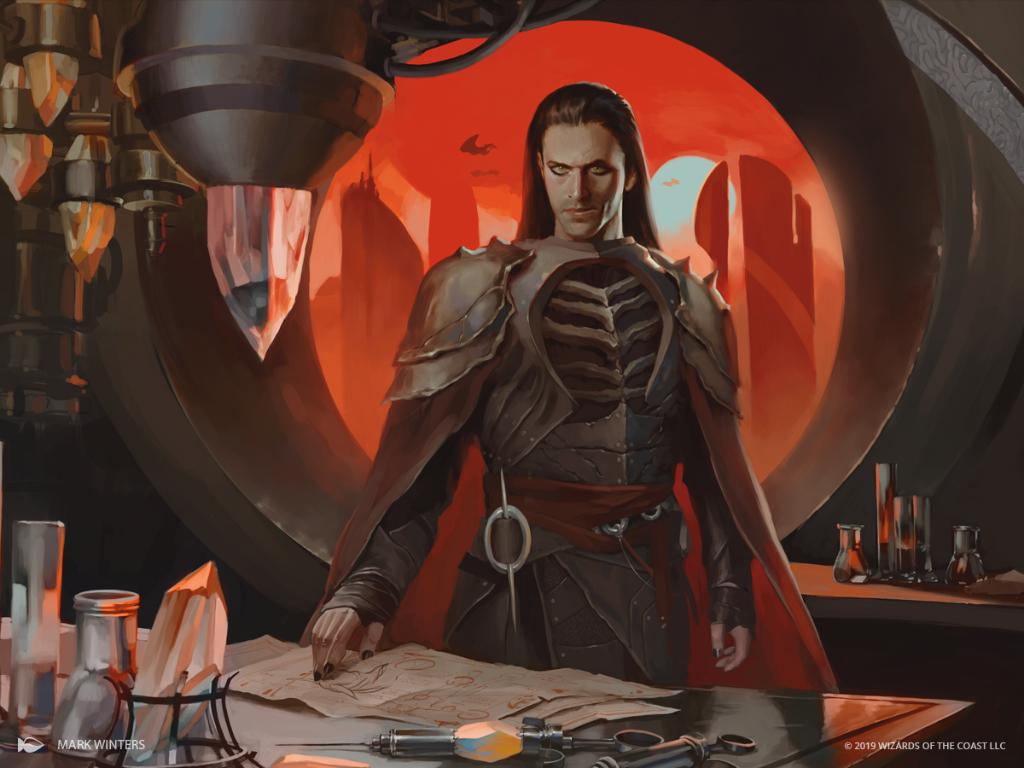Yawgmoth Combos with Agatha's Soul Cauldron (AKA Yawgmoth 102)
TLK Member and GB creatures fanboy Joe Vetti breaks down the new combos in Modern GB Yawgmoth with the addition of Agatha's Soul Cauldron.

With GB Yawgmoth emerging as one of the most popular decks in today’s post-Wilds of Eldraine Modern metagame, players have been moving to pick up the deck at a much faster rate than ever before. This has shifted it from a “specialist” deck into one widely utilized by pro level players and tournament grinders (check out our latest Week 7 Power Rankings article). This past weekend, Yawg put 14 lists into the top 32 across the four MTGO Challenges including a win on Friday, October 20 and a second place finish in one of the Saturday, October 21 Challenges. I’m here with this article to help players new to the deck get up to speed with the changes and new combos Agatha’s Soul Cauldron has brought with a sort of “Yawgmoth 102” course.
The List
Cauldron Yawg
By Joe Vetti
Recently, most lists have been consolidating around a similar shell to leave only a few flex slots in the main deck, such as the choice of the final one-of and deciding between the extra mana dorks v. lands. Lists are locked into 4 Delighted Halfling, with the other mana dork slots usually being some variation of 21 lands and 2 Ignoble Hierarch; 21 lands, 1 Ignoble Hierarch, and 1 Dryad Arbor; or 22 lands and 1 Ignoble Hierarch (or Gilded Goose, depending on preference and metagame). The one-of typically varies between Endurance, Eldritch Evolution, Haywire Mite, Sheoldred, The Apocalypse, or Fulminator Mage.
Sideboards have some variation based on preference and metagames, such as the inclusion of Thoughtseize or Veil of Summer, whether to run Elven Chorus or The One Ring, the pieces of removal included, and, most important for the purposes of this article, whether to run Spike Feeder (which readers can see I currently do not).
Yawgmoth 101
If you’ve played with or against Yawgmoth in the past, you can probably skip this quick, get-you-up-to-speed section on the “traditional” combo. Basically, Yawgmoth, Thran Physician is the deck’s main engine and source of card advantage. A Yawgmoth and 2 creatures with undying in play (any combination of Young Wolf, Strangleroot Geist, or Hapatra, Vizier of Poisons) works as a build-your-own Yawgmoth’s Bargain, where you pay 1 life and sacrifice one of your creatures without a +1/+1 counter targeting one with a +1/+1 counter, to remove the counter, which resets the undyer, and draw a card. Your board is essentially the same at this point, with the undyer that had the counter now being without one (the -1/-1 from Yawgmoth cancels out the +1/+1 from the undying ability) and the sacrificed undyer has a counter (alternatively, if Hapatra is in play for this, you sacrificed the snake token targeting your undyer, either killing the undyer or removing the +1/+1 counter and creating another snake, which you then repeat). The same board with a Blood Artist or Zulaport Cutthroat will keep your life total the same (you lose 1 to pay for Yawgmoth’s ability, then gain 1 back from your creature dying) while pinging your opponent for 1 damage each time you sacrifice a creature. This same board with Sheoldred, the Apocalypse will net 1 life with each card drawn, allowing you to draw your deck.
Yawgmoth 102 - Soul Cauldron Combos
Here’s why you’re reading this article, the Agatha’s Soul Cauldron combos. The deck now has enough true infinite combos to make an EDH player cry (the Endurance loops you could do in the deck before don’t count, these are true infinite lines not limited by something so small like the number of green cards in your deck). I’ve broken this part down into sections by focusing on which card is exiled with (or “under”) your Cauldron, those sections being (1) Yawgmoth, Thran Physician, (2) Grist, the Hunger Tide, (3) Walking Ballista, (4) Spike Feeder, and (5) Miscellaneous Cards, with the Ballista and Spike Feeder lines summarized in a table at the end.
But before we begin, here are six Cauldron tips/interactions that might be useful.
- Each Cauldron “sees” only its own exiled cards. For example, if you have a Yawgmoth under your Cauldron, which then gets exiled with a Leyline Binding, that Yawgmoth’s abilities are gone if you destroy the Binding with the channel ability of Boseiju, Who Endures to return your Cauldron to play.
- Cauldron’s ability works by targeting a creature in a graveyard (it can be any card, but this is only relevant for creatures) before your opponent knows which of your creatures you would like to place the +1/+1 counter on. The next part of Cauldron’s ability is a reflexive trigger (like Grist’s -2), so there is a trigger to place the +1/+1 counter on the stack, targeting your creature, that can then be responded to. That said, any existing creatures with +1/+1 counters in play now have the ability of whichever card you just exiled, so you could have the chance to respond with the new ability if your opponent tries to remove whatever you are trying to place the +1/+1 counter on.
- Don’t forget about Cauldron’s static ability, which lets you activate abilities with any color of mana. Primarily, this is incredibly helpful in using Yawg’s proliferate ability (USE THIS ABILITY! One of my biggest tips to new Yawg pilots is to proliferate more.).
- Keep an eye on your opponent’s graveyard because you can sometimes make use of their activated abilities. Two examples I personally have are beating a Scales player by exiling their Zabaz, the Glimmerwasp to give my creatures flying to both block their Inkmoth Nexus and then swing for lethal the next turn and beating a Twiddle Storm player by playing a Cauldron, exiling their Vizier of Tumbling Sands, and using the untap ability to assemble a Walking Ballista combo on the same turn.
- When you have multiple Wall of Roots under your Cauldron, you can add a -0/-1 counter to make a green mana for each Wall of Roots under your Cauldron (e.g., a Yawgmoth with a +1/+1 counter and 3 Walls under your Cauldron gives you the option to place 3 -0/-1 counters on Yawg to add GGG).
- Grist, the Hunger Tide does not work like Wall of Roots because a permanent can only activate a single loyalty ability once per turn (see Rule 606.3) (e.g., a Yawgmoth with a +1/+1 counter and 3 Grists under your Cauldron only gives you the option to use a single Grist loyalty ability each turn).
Finally, three notes for the purposes of this article. First, if I discuss Yawgmoth being in play, having a Yawgmoth under your Cauldron with an additional creature with a +1/+1 counter on it does the same thing for purposes of the combo. Second, although Hapatra functions the same as the undying creatures in the traditional combo, it does not with Cauldron combos, so a mention of an undyer below is referring to either Young Wolf or Strangleroot Geist. Third, Delighted Halfling, Ignoble Hierarch, and Dryad Arbor are essentially interchangeable under Cauldron and any mention of a “mana dork” can refer to any of them (other than needing green mana for a non-legendary spell, like Chord of Calling).
1) Yawgmoth, Thran Physician
A Yawgmoth under your Cauldron does not open up any new lines per se but does provide extra (even multiple) copies of Yawg, which is always a good thing. You can execute the traditional combo discussed above in Yawgmoth 101 with your Cauldron and only two undyers in play, because the undyer with the +1/+1 counter can target itself with the sacrifice ability thanks to not having protection from humans (a Hapatra with a +1/+1 counter and one undyer works as well, with Hapatra functioning as Yawgmoth). Another thing to note for the mirror match is Cauldron now gives you the option to shrink their Yawgmoth with your new “Yawgmoths” because they’re non-human creatures.
2) Grist, the Hunger Tide
A Grist under your Cauldron functions mostly the same as having one (or multiple) in play, with one combo exception I’ll address in the Ballista section below. To start, Magic’s rules allow any permanent to activate loyalty abilities (assuming it has them), not just planeswalkers, so your creatures with +1/+1 counters can all use Grist’s abilities because Grist is a creature everywhere other than on the battlefield. That said, any non-planeswalker permanents start with 0 loyalty counters, so you need to spend some turns using the +1 ability before having access to the -2 or -5 abilities. Keep in mind that a Grist under your Cauldron is incredibly powerful in grindy/midrange matchups because adding multiple creatures to your board (and adding multiple cards to your graveyard for your Cauldron) will break a board stall very quickly.
3) Walking Ballista
Buckle up, this is where things get complicated. Walking Ballista is both the most complicated and most powerful creature (as far as combos go) to have under your Cauldron. I’m breaking this into a Part A and a Part B, separated by what you are targeting with the Ballista pings as you go through the loops. Part A has you targeting your opponent and requires access to Yawgmoth, while Part B has you targeting your own undyer.
Part A - Targeting your Opponent
With Ballista under your Cauldron and an undyer and Yawgmoth in play, you can damage your opponent equal to your current life total. To do this, you use your undyer’s Ballista ability to remove the +1/+1 counter to deal 1 damage to your opponent, then use Yawgmoth’s ability to sacrifice your undyer targeting itself (or another creature, if there is one in play) to reset the +1/+1 counter from undying (and drawing a card if Yawg’s ability resolved by placing a -1/-1 counter on a creature). Next, with the same setup but two undyers (so Ballista under Cauldron, Yawg, and 2 undyers), you can damage your opponent equal to twice your current life total. To do this, repeat the same steps as the above combo, but you will use the Ballista ability on both the undyers (dealing 2 damage) and then target the second undyer with Yawg’s ability. For example, you remove a +1/+1 counter from each of your two Young Wolfs, targeting your opponent to deal 2 damage, then use Yawgmoth’s ability to sacrifice one Young Wolf targeting the second. They both die and come back with a counter, which allows you to loop this for -2 opponent’s life, -1 your life, and +1 card each loop. Finally, you can deal infinite damage to your opponent with the first loop (undyer + Yawg) with a Blood Artist in play (if decking yourself is a concern, make sure you are targeting the undyer with Yawg). Fun fact though, Yawgmoth isn’t actually needed to kill with this line, bringing us into Part B.
Part B - Targeting your Undyers
All of Part B is made possible by your undying creatures having 1 base toughness and using the Ballista ability to target itself, so creatures like Geralf’s Messenger, Vorapede, or Garbage Elemental wouldn’t work for these lines. Continuing from the end of Part A, with Ballista under your Cauldron and an undyer and Blood Artist in play, you have infinite damage and infinite lifegain. To combo here, your undyer targets itself with its Ballista ability, which kills the itself, triggering the Blood Artist to drain for 1 and reset the +1/+1 counter with the undying trigger, allowing you to infinitely loop killing your undyer. Next, with a similar line, a Ballista and a Wall of Roots under your Cauldron with an undyer in play will produce infinite green mana and infinite damage. Here, use Wall of Roots’ ability to add a -0/-1 counter to your undyer and float G (making your undyer an X/1 with a +1/+1 counter, because the -0/-1 and the +1/+1 do not cancel each other out), and then use Walking Ballista’s ability to remove the +1/+1 counter targeting your opponent. When the counter is removed, your undyer dies from state-based actions (because it is an X/0 creature from the Wall of Roots -0/-1 counter) which triggers undying and returns your creature to play with a +1/+1 counter again. Repeat this loop to kill your opponent, wipe their board, basically just do whatever at this point because you’ve transcended the rules of Magic and have unlimited power.
The third combo in Part B requires Ballista and a mana dork under your Cauldron and a Strangleroot Geist in play to produce infinite mana and infinite damage. To do this, tap your Strangleroot Geist to float a mana and then use its Ballista ability to shoot itself, returning it to play untapped with a +1/+1 counter. Continue floating mana with this loop until you have enough to activate Walking Ballista's 4-cost ability to add enough +1/+1 counters to kill your opponent. The final combo here requires Ballista and Grist, the Hunger Tide under your Cauldron and an undyer in play to produce infinite 1/1 insect tokens (which also mills your deck, so have a plan to not deck yourself if you do choose to produce infinite tokens). Much like the Geist combo above, you activate Grist’s +1 loyalty ability to create an insect and mill a card and then use the Ballista ability to reset your undyer to loop this process. Unlike the other Ballista combos, creating the insects doesn’t directly kill your opponent so you will need to have a plan and hope you don’t die before winning the game. Common outs here include making enough insects to swing for lethal the next turn (and not dying during your opponent’s next turn), having a Chord of Calling in hand to grab your Blood Artist to perform that loop (assuming you don’t mill your Blood Artist off the Grist ability, or have an Endurance + green card in hand to shuffle your graveyard back in), or having a Grist in play with 5+ loyalty to use the -5 ability to kill your opponent.
4) Spike Feeder
As I mentioned earlier, I personally do not run Spike Feeder in my current list, but still think it is worth discussing both as a potential future meta call or preference inclusion (or if you really hate burn players). With a Spike Feeder under your Cauldron and an undyer and Yawgmoth in play, you have the ability to gain infinite life. To do this, use Spike Feeder’s ability to remove the +1/+1 counter from your undyer to gain 2 life. Then, pay 1 life to use Yawg’s ability to sacrifice the undyer, either targeting another creature to draw a card or targeting itself to prevent decking yourself (because this fizzles both the card draw and the -1/-1 counter). You have gained 1 life at the end of this, so repeat this loop to draw as much as you want or gain infinite life. Adding another undyer will let you draw your deck by sacrificing your first undyer targeting the second (or you can draw cards equal to the toughness of other creatures in play), while adding a Blood Artist to the board will kill your opponent while performing either of the two loops above.
5) Miscellaneous Cards
The two main cards I’m addressing here are Fulminator Mage and Haywire Mite. Fulminator Mage turns all of your creatures with +1/+1 counters into copies of Wasteland, making your Orcish Bowmasters even stronger by letting the army destroy lands as soon as it comes into play. Something to keep in mind with Bowmasters when playing against The One Ring is that each draw results in a separate Bowmasters trigger, allowing you to respond between them to either sacrifice each army token to Yawgmoth to draw a card as it’s created, or use the Fulminator ability each time the army is created. For example, you have a Fulminator under your Cauldron and an Orcish Bowmasters as your only creature in play and your opponent activates The One Ring to draw 4 cards, triggering your Bowmasters 4 times. With your 4 Bowmasters triggers, you can point a damage where you wish, create an army token, and sacrifice your army to destroy a nonbasic land (before the next ping + amass trigger resolves) up to 4 times, which leaves your board the same as it was and your opponent’s a few lands lighter.
Haywire Mite is more self-explanatory, where you get to turn any of your creatures with a +1/+1 counter into a Naturalize (but only for non-creatures) for a single green mana. Note that you do not gain the life from the other creatures using the Mite’s ability because that’s a triggered ability.
Walking Ballista and Spike Feeder Summary Table
The table below summarizes the Ballista and Spike Feeder lines I covered in (3) and (4) above, with the three columns being what is under your Cauldron, what is in play, and the end result. The lines to get there are described above.
Thanks for reading today! Hopefully you've walked away with the incentives and combo lines you need to play this extremely powerful deck this week at FNM or your next local RCQ. There is obviously much more to the deck than what I've written about here, but hopefully I've given you the base tools you need to find your lines based on the boardstate each game. Until next time, and may all your Grist +1's hit insects.
-Joe Vetti



Comments ()